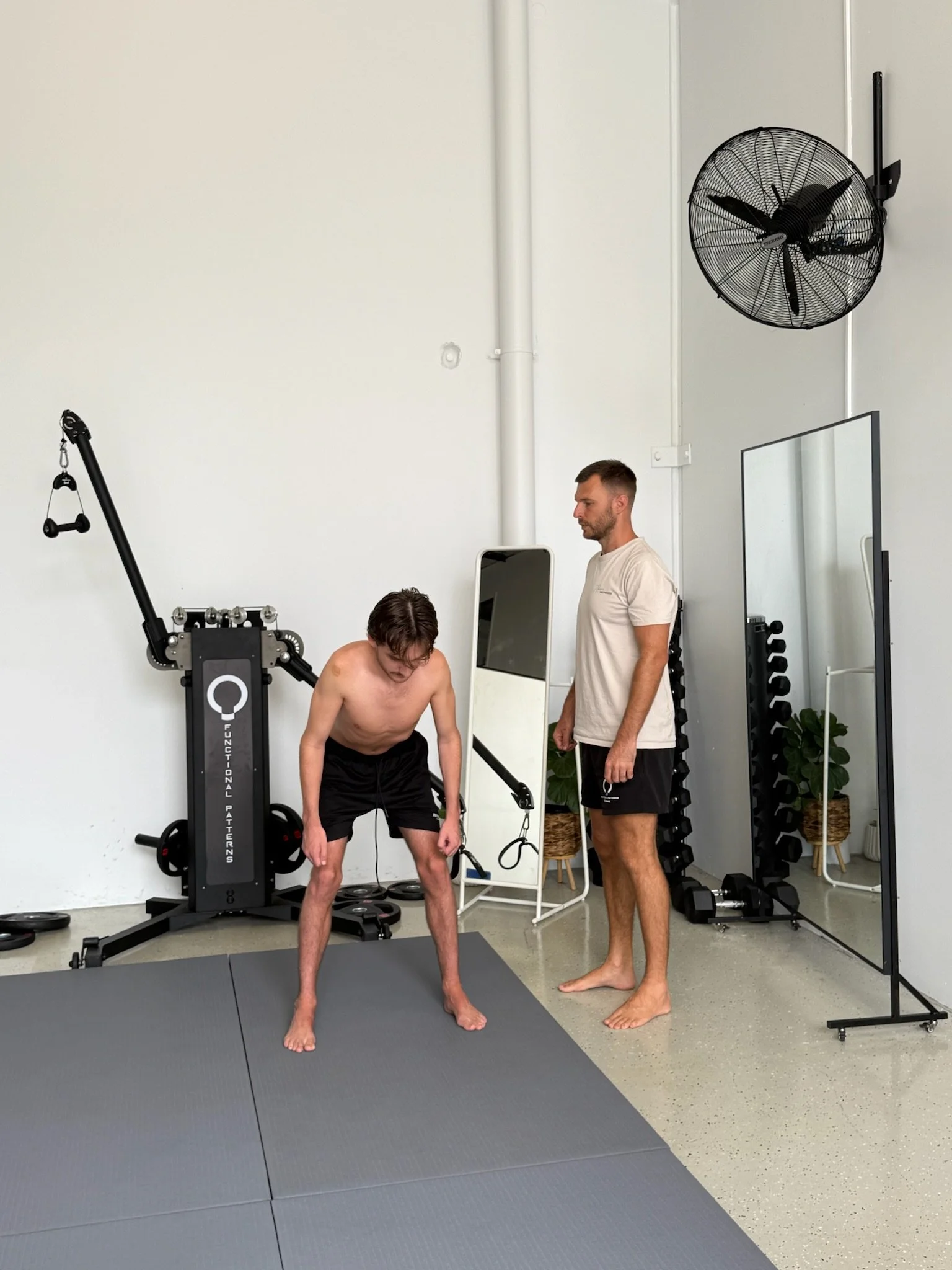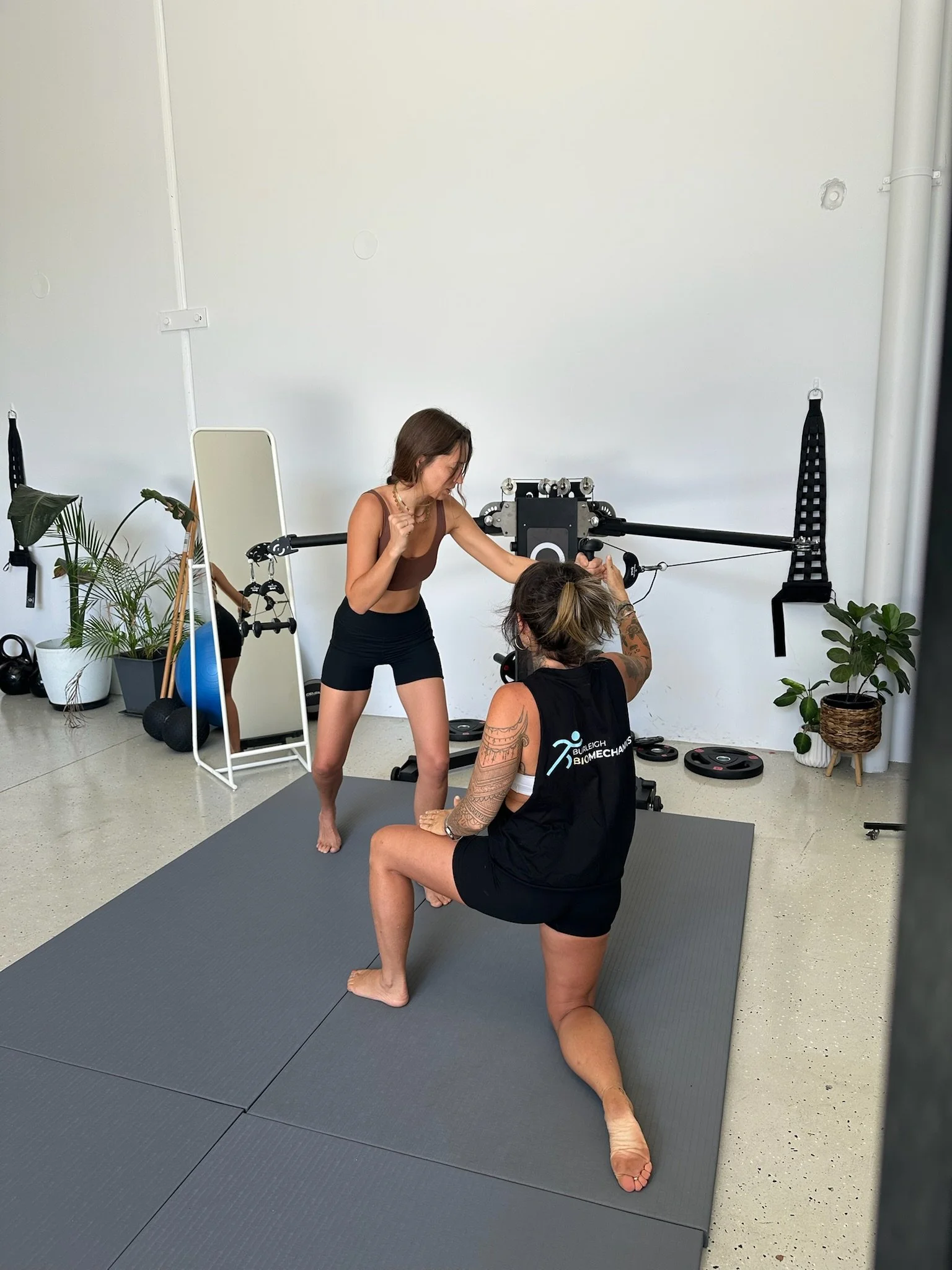
Running Gait Analysis & Biomechanics — Gold Coast
Stop guessing what’s wrong with your running. We use full-body running biomechanics to explain why you’re sore — and show you exactly how to fix it.
If your hip hurts after running, you’ve got shin splints, Achilles tendon pain, or knee pain that won’t settle, the problem isn’t your “bad joint” — it’s how your whole body moves.
At Burleigh Biomechanics, our Running Lab combines running gait analysis, cadence assessment, and Functional Patterns–based rehab to correct the root cause of your pain.
Why runners need more than generic physio
Most runners are told to:
“Strengthen your glutes”
“Do some core work”
“Stretch your calves or IT band”
…but still end up with:
The same running and Achilles tendon pain
Retropatellar knee pain every time they increase distance
Shin splints that flare with speed work
Hips that ache for days after long runs
That’s because your running injuries are biomechanical, not just muscular.
We look at how your ribs, pelvis, hips, knees, ankles and feet share load with every step..
“Reduced hip extension and poor pelvic control are strongly associated with common running injuries, including patellofemoral pain, iliotibial band syndrome, and Achilles tendinopathy.”
— Clinical Biomechanics
Who our Running Lab is for
Your hip hurts after running or walking hills
You’ve had shin splints and still wonder how to help shin splints long term
You’ve been told you have iliotibial friction syndrome or IT band issues
You get retropatellar knee pain (runner’s knee) or jumper’s knee
You feel tight calves or Achilles with every run
Your ankles, knees or hips click when you run
You’ve tried strength programs, shoes and taping but the pain keeps coming back
You want to improve cadence and running efficiency without guesswork
Don’t Take it From Us!
-
Burleigh Biomechanics has an incredibly knowledgeable team employing Functional Patterns training. If you’re looking for help to overcome neck pain, back pain, shoulder pain or healing from an injury, this is the place to be.
Verified 5 Star Google Review
-
Been training with Jen at Burleigh Biomechanics. Before I started with Functional Patterns my body was a mess, constant pain and headaches. Now I’m pretty well pain free, feeling great physically and mentally.
Verified 5 Star Google Review
-
My body has been dysfunctional for the past 30 years and, I have been in pain and unable to live my life to the fullest for the last 10 of those... I have been working with Jen for a year now and have made huge improvements to the way my body moves and pain levels.
Verified 5 Star Google Review
What happens in a Running Gait Analysis
-
Step 1 – Movement & history assessment
We take a detailed history of your
running volume,
surfaces,
niggles and injury history.
We talk aboutt the other sports or activities you partake in how these affect your running biomechanics.Then we assess your standing posture to see how you load before you even start running.

-
Step 2 – Running gait analysis (video + biomechanics)
We film your running from multiple angles and analyse:
Foot strike and foot tripod control
Tibial rotation and knee tracking
Pelvic rotation and hip extension
Ribcage mechanics and arm swing
Cadence and running rhythm
This lets us go beyond “overpronation” and pinpoint where in the chain things are breaking down.

-
Step 3 – Explain your injury in plain language
We show you, frame by frame, how your current mechanics link to:
Running and Achilles tendon pain
Shin splints / split shins
Retropatellar knee pain
Jumper’s knee
Or any other symptom you’re dealing with
You leave knowing exactly why it hurts — not just a diagnosis label.

-
Step 4 – Corrective plan based on Functional Patterns
You’ll get a targeted plan to improve your:
Hip and pelvis control
Glute-driven hip extension
Trunk rotation and ribcage alignment
Foot and ankle stability
Cadence and impact management
Overall Symmetry.
All drills are built around real running, not random gym exercises.

Running injuries we assess & treat
-
If you’re searching for “running gait analysis near me” around the Gold Coast, our Running Lab in Burleigh focuses on whole-body running biomechanics, not just how your foot hits the ground. We assess how your ribs, pelvis, hips, knees and ankles work together so you finally understand the real cause of your pain.
-
“Fix your cadence” is common advice, but forcing a number without fixing your mechanics can create new problems. We look at cadence and running in context: how your step rate relates to ribcage rotation, pelvic timing, and hip extension. When the pattern is right, cadence tends to improve organically.
-
Running and Achilles tendon pain usually means your calf is doing the job your glutes and hips should be doing. We unload your Achilles by improving:
Glute-driven hip extension
Foot strike mechanics
Tibial rotation and ankle stiffness
This reduces tendon irritation while making your stride more efficient.
-
If your hip hurts after running, the problem is often a rotation imbalance at the pelvis or poor glute integration. We assess how your pelvis moves with each step and retrain the pattern so your hip can handle load without flaring up after every run.
-
Iliotibial friction syndrome isn’t solved by endlessly stretching or foam rolling. The IT band is being tensioned because the hip isn’t stabilising properly in stance. We restore hip stability, improve pelvic control and refine your running alignment so the lateral knee pain settles.
-
Wondering how to help shin splints without just resting? Shin splints are usually a sign that your tibia and foot are taking too much force because the hips and trunk aren’t absorbing load. We:
Build a stronger foot tripod
Improve hip and pelvis control
Optimise cadence and stride length
so load disperses more evenly through the chain.
-
People often describe intense shin pain as “split shins”. This is a sign that your lower leg is acting as a shock absorber it was never designed to be. We correct your running form, ensuring the glutes, hamstrings and trunk take their share of the impact, not just the shins.
-
Retropatellar knee pain in runners comes from timing errors between hip drive, tibial rotation and foot strike. We use running gait analysis to see exactly how your knee is being compressed, then retrain the coordination so the kneecap tracks without constant irritation.
-
With jumper’s knee, the patellar tendon is overloaded because the quads are doing too much and the hips too little. We shift your running mechanics toward glute-driven propulsion so the tendon finally has a chance to calm down.
What to Expect in Your Sessions
-

Your initial session includes:
Slow-motion gait & posture analysis
Rib, pelvis and jaw mechanics assessment
Breathing pattern assessment
Strategy session + personalised plan
Around 30 minutes of functional training
Individualised myo fascial release training -

Your follow-up sessions focus on:
Global integration drills (no isolated neck exercises)
Reducing compression patterns
Teaching your system to stabilise without gripping
Improving jaw freedom through whole-body mechanics
Measurable changes in your movement and symptoms
Our goal is not temporary relief — it’s long-term correction.
Book An Initial Appointment
Here’s What You’ll Get in Your First 90 Minutes
A full gait + posture assessment
We analyse how your body actually moves—not just where it hurts.Clear diagnosis of what’s driving your pain
You’ll leave knowing exactly which patterns are causing the problem.A personalised plan that actually holds
No generic exercises. Precise, FP-based sequencing matched to your body.Immediate hands-on corrections
We start improving muscle timing, rotation, and symmetry in session one.A roadmap for long-term change
Feel the difference now, and know the exact steps to keep improving.
Book A Running Assessment
Free 3-Page Guide
The 5 Mistakes That Keep Injuries Coming Back
Learn what’s preventing your injury from fully resolving — and how to fix the underlying movement pattern for good.
Located in Burleigh Heads on the Gold Coast — easily accessible from Miami, Palm Beach, Burleigh Waters, Tallebudgera and Varsity Lakes.




